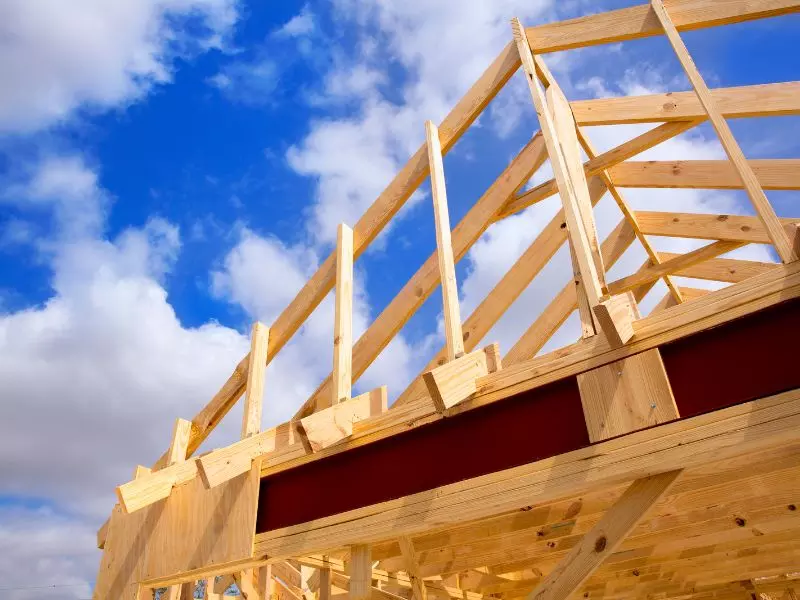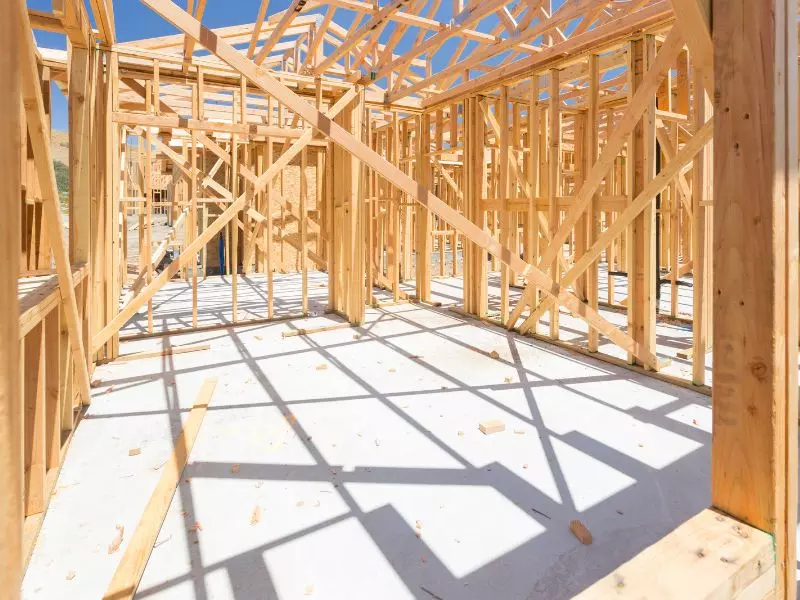
Construction framing is a critical component of the building process, providing the structure and support for the rest of the building.
The framing includes the walls, floors, and roof systems, and it must be done correctly to ensure the building's structural integrity and longevity. Quality wood framing is crucial to the success of any construction project, as it impacts everything from energy efficiency to aesthetics. For example, poorly framed buildings can be susceptible to structural failures, causing damage and even endangering occupants. On the other hand, well-framed buildings can withstand natural forces such as wind, seismic activity, and heavy snow loads. Quality framing can also improve energy efficiency by reducing thermal bridging, leading to significant cost savings on heating and cooling bills. In fact, according to the US Department of Energy, energy-efficient framing can reduce energy costs by up to 30%. Moreover, quality framing can prevent issues related to moisture, rot, and pests, which can lead to costly maintenance and repairs over time. Additionally, well-executed wood framing can provide more design possibilities and flexibility, allowing for unique and aesthetically pleasing finishes to increase the building's overall value.
This article will dive deeper into quality framing and uncover why it is essential for ensuring the structural integrity, energy efficiency, longevity, and aesthetic appeal of a building.
How Wood Framing Contributes to Structural Integrity and Safety
Structural integrity and safety are crucial considerations in any construction project, and quality framing is vital in ensuring both. Here are three ways that quality framing contributes to structural integrity and safety:
A. Proper load distribution:
Framing is responsible for distributing the weight of a building and any additional loads it may experience, such as from snow, wind, or people. If framing is not done correctly, it can cause uneven weight distribution, leading to cracks, sagging, or even collapse. High-quality wood framing ensures the load is evenly distributed, preventing potential issues and ensuring structural integrity.
B. Resistance to natural forces (wind, seismic, etc.):
A building must withstand natural forces such as wind and seismic activity. The framing of a building plays a critical role in this resistance, providing support and stability. Quality framing is essential in ensuring that construction can withstand these forces, providing occupants with a secure and safe environment.
C. Prevention of structural failures:
One of the most critical aspects of quality framing is its ability to prevent structural failures. These failures can result from many factors, such as improper design, inadequate materials, or poor workmanship. When framing is done correctly, it can prevent failures caused by these factors, ensuring that the building will stand firm for many years. Overall, quality framing is essential for ensuring the structural integrity and safety of a building. Proper load distribution, resistance to natural forces, and the prevention of structural failures are all crucial factors that depend on quality framing. When framing is done correctly, it provides a safe, secure, and reliable foundation.
How Wood Framing Contributes to Energy Efficiency and Thermal Performance
A. Role of framing in insulation and thermal bridging
When it comes to energy efficiency and thermal performance, framing plays a crucial role in the insulation of a building. The framing system provides structural support for the insulation and helps to reduce thermal bridging, which occurs when heat is transferred through the framing material and bypasses the insulation, resulting in energy loss and higher heating and cooling costs. To minimize thermal bridging, builders can use insulated framing materials, such as Structural Insulated Panels (SIPs), Insulated Concrete Forms (ICFs), or double-stud walls. These materials have higher R-values, which measure the resistance to heat flow, and reduce the amount of heat that passes through the walls and into the interior of the building.
B. Impact on heating and cooling costs
The quality of framing can also have a significant impact on heating and cooling costs. A well-framed building with proper insulation can reduce energy consumption and lower heating and cooling bills. According to the Department of Energy, heating and cooling account for nearly half of the energy use in a typical home, and poorly insulated walls and roofs can result in up to 40% energy loss. By investing in quality framing and insulation, homeowners and builders can create an energy-efficient building that requires less energy to heat and cool, saving money, reducing greenhouse gas emissions, and supporting sustainability.
C. Contribution to overall building energy performance
Finally, the framing system contributes to the overall energy performance of the building. A building's energy performance is measured by its Energy Efficiency Ratio (EER) or Seasonal Energy Efficiency Ratio (SEER). These ratios measure the amount of energy consumed in relation to the cooling output of the air conditioning system. By incorporating quality framing and insulation, builders can improve a building's EER or SEER rating, making it more energy-efficient and reducing the environmental impact. In addition, an energy-efficient building can also increase property value and appeal to eco-conscious buyers.
How Wood Framing Contributes to Longevity and Durability

A. Effects of Quality Framing on Building Lifespan
Quality framing is a crucial aspect of constructing a building that will stand the test of time. The quality of the framing can directly impact the building's lifespan, as well as the safety and well-being of its occupants. A well-framed building is less likely to experience structural issues and requires less maintenance. In addition, quality framing can help to reduce energy costs over the life of the building. A well-framed building will be more energy-efficient, as it will be better insulated and less prone to air leaks. This ability to withstand leaks can reduce heating and cooling costs, which can be a significant expense over the life of a building.
B. Prevention of Issues Related to Moisture, Rot, and Pests
One of the key benefits of quality framing is that it can help to prevent issues related to moisture, rot, and pests. Poorly framed buildings are more susceptible to moisture intrusion, leading to mold growth, corrosion, and other issues. Quality framing techniques, such as adequately sealing the building envelope and using moisture-resistant materials, can help prevent these issues. In addition, quality framing can help to prevent pest infestations. Poorly framed buildings can have gaps or cracks that allow pests to enter, leading to damage and potential health hazards. Quality framing can help prevent these issues by ensuring the building is properly sealed and constructed to minimize pest intrusion.
C. Maintenance Requirements and Long-Term Costs
Another important aspect of quality framing is that it can reduce maintenance requirements and long-term costs. As outlined earlier, a well-framed building will generally require less maintenance over time, making it less likely to experience moisture intrusion, rot, or pest infestations. This can help to save building owners money in the long run, as they will not need to invest as much in repairs or maintenance.
How Wood Framing Contributes to Aesthetics and Architectural Flexibility
Framing is not just about providing structural support for a building; it also plays a crucial role in the overall design of a structure. Quality framing can enable various design possibilities, including creating open-concept spaces, unusual angles, and intricate architectural details. Moreover, skilled framers can work with architects and builders to customize the framing to meet specific design goals. For example, wood framing can create a unique roofline, support a large window or skylight, or add character to a room with exposed beams or trusses.
One of the most critical aspects of quality wood framing is ensuring that everything is properly aligned and installed. Accurate wood framing can prevent issues such as uneven floors, doors that don't close properly, or wall cracks. In addition, proper alignment is essential for achieving high-quality finishes. For example, if the framing for a door or window is not installed correctly, it can cause the frame to warp or shift over time, making it difficult to install or replace the door or window. Lastly, quality wood framing can also help to avoid issues with other building components, such as doors and windows. When done correctly, it can provide a solid and stable foundation for these components, preventing them from becoming loose, wobbly, or challenging to open or close.
Conclusion
In conclusion, quality framing is essential to ensure the safety, energy efficiency, longevity, and aesthetic appeal of a building. By investing in high-quality wood framing, you can avoid structural failures, reduce energy costs, increase the lifespan of your building, and achieve a beautiful finish that meets your design goals. At Wells Custom Framers, we are committed to providing our clients with reliable and professional framing services. With our expertise, experience, and commitment to using best practices and high-quality materials, we can ensure that your framing needs are met with excellence.
